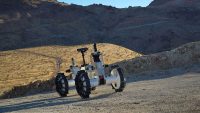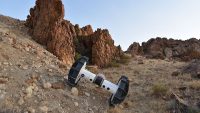During the same field test, the DuAxel rover separates into two single-axled robots so that one can rappel down a slope too steep for conventional rovers. (NASA/JPL-Caltech/J.D. Gammell)
Home During the same field test, the DuAxel rover separates into two single-axled robots so that one can rappel down a slope too steep for conventional rovers. (NASA/JPL-Caltech/J.D. Gammell) During the same field test, the DuAxel rover separates into two single-axled robots so that one can rappel down a slope too steep for conventional rovers. (NASA/JPL-Caltech/J.D. Gammell)




